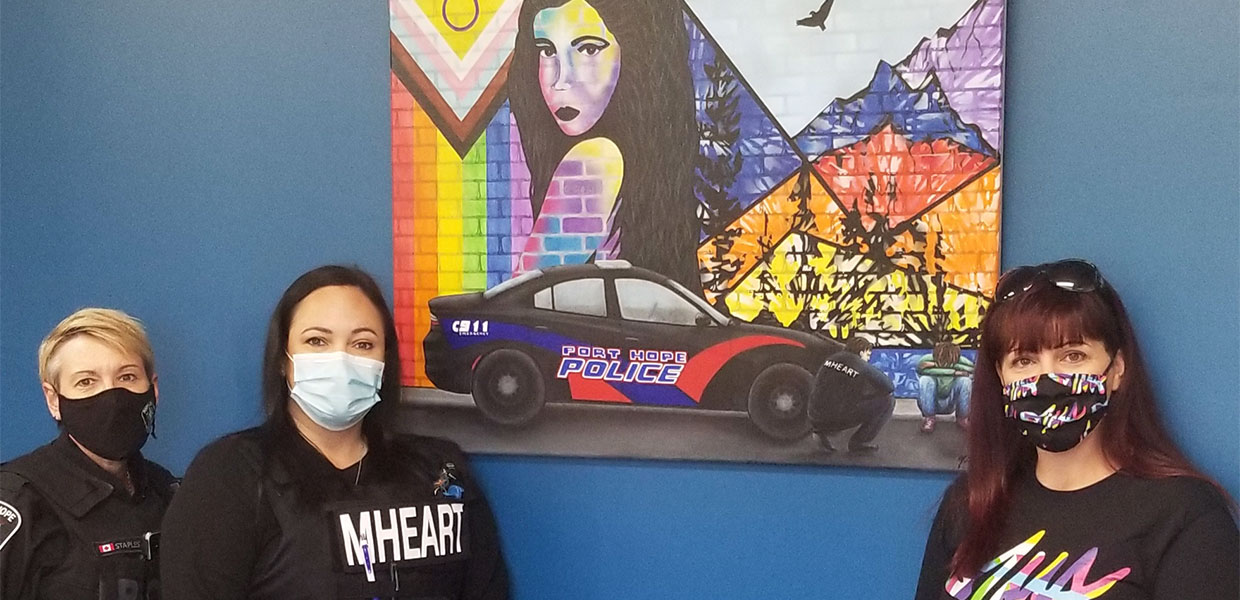NHH and Port Hope Police Service unveil new painting spotlighting integrated M-HEART service

A strong partnership between Northumberland Hills Hospital’s Community Mental Health Service and the Port Hope Police Service (PHPS) was highlighted last week with the delivery of a painting now hanging in the PHPS building at 55 Fox Road, Port Hope.
Jointly commissioned by the hospital’s community mental health team and the PHPS, the 1X1.5- metre piece is the work of multidisciplinary artist Michelle Akil. A graduate of Centennial College and the Ontario College of Art and Design University, her work in this instance is spotlighting a small service that has already had a big impact on the Port Hope community in the three years since its introduction.
Strategically displayed in the Community Room of the PHPS, the brightly coloured mixed media scene depicts the image of a youth, head in hands, sitting on the ground beside a Port Hope Police cruiser with a male member of the M-HEART team bending down to assist. “The backdrop of the scene is a mural with imagery that includes indigenous, LGBTQ2+ and other symbolism representing inclusivity, together with a mix of urban and rural landscapes,” said Akil. “It is meant to provoke awareness of inclusion, diversity and breaking barriers, and another way to continue the discussion of mental health overall.”
M-HEART—the acronym stands for Mental Health Engagement and Response Team—has been a fixture of the PHPS since the late fall of 2018, shortly after it was introduced in the region thanks to new funding from the then Central East Local Health Integration Network (now Ontario Health East). Similar M-HEART teams are also in place at both the Northumberland OPP and the Cobourg Police Service.
“While we are a police agency, only 20 percent of our service calls to the Port Hope Police Service are actually for criminal activity,” shared Bryant Wood, Chief of Police. “Eighty percent of the calls we get are actually what I call society issues. People needing help, quickly, and many of those are associated with mental health needs. By pairing an NHH Mental Health Nurse with an existing Mental Health Response and Liaison Officer from our service, we have found that we can get care quickly and directly to those who need it most, when they need it.”
Kristen Balkissoon, the Mental Health Nurse assigned to the PHPS, and the instigator behind the painting idea, spends three days a week riding along with her Port Hope Police Service counterpart, Constable Tammy Staples. Together they jointly and proactively engage with individuals in the community with mental health and/or addiction issues.
“Our partnership is like a puzzle,” says Staples. “We are there to help, but we don’t just deal with mental health… it may be homelessness or even literacy… just like the painting, if you look at these situations we are called to, they are quite often the result of many factors overlapping.”
“As a nurse, with special training in mental health needs, I am here to provide a mix of supports, curbside, just as Michelle’s painting depicts, including intensive case management, mental health therapeutic treatment, family supports, assertive outreach, advocacy, linkage to hospital-based and community resources, medication administration as well as primary care connection,” said Balkisoon. “Every individual we connect with has unique needs, but overall our goal is to support longer term stabilization of vulnerable people living in the community and, where necessary and possible, link them with other supports beyond the health and justice sectors, such as income assistance and housing support.”
From a partnership perspective, M-HEART provides an opportunity to not only bring care to individuals in need in Northumberland—often averting a trip to the Emergency Department—it is also fostering the development of trusting relationships between vulnerable individuals and those who are here to support.
“System navigation is challenging for so many of our clients and families,” said Emma Taylor, Interim Director of NHH’s Community Mental Health Service. “There are many barriers, from trust to literacy to transportation. And without support, as we know, small challenges can grow. The purpose of M-HEART (and we have certainly seen its benefit in Port Hope) is to connect people in need sooner, before issues escalate, with a street-level strategy that works together with the client on permanent solutions. We are hopeful that Michelle’s beautiful artwork will help us to raise further awareness of the service in the community.”
Mobile crisis intervention is one way the local police service is working with their hospital partners to better connect those in need with the services available in the community. System-level benefits are being seen as a result of the M-HEART program, from the development and implementation of coordinated care plans, empowering client and their families to participate in care planning while keeping members of the support system informed. In 2021 calls to M-HEART increased by 169 per cent over 2020, with 63 per cent more unique individuals served from year to year and a 65 per cent increase in emergency department diversions, meaning that 65 per cent more calls were able to be managed in the community rather than resulting in a hospital emergency department visit.
“This program is a win for all involved,” added Chief Wood. “First and foremost, it’s good for the people we’re here to serve, it’s good for our police service, as it brings specialized mental health skills to the street where they’re needed most, and it’s good for the local health care system, by reducing crisis visits to the Emergency Department. With continued government support, we look forward to building on the strength of the M-HEART model in the months and years ahead, and expanding access through increased resources in Port Hope cruisers.”
